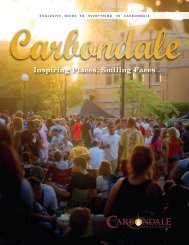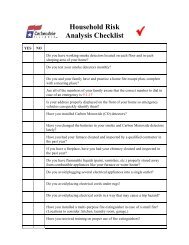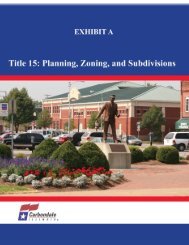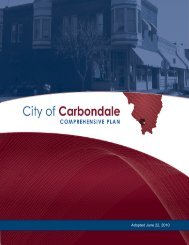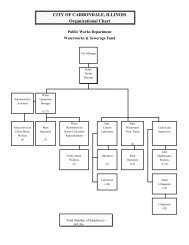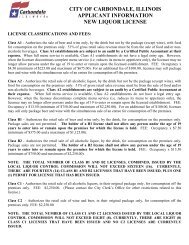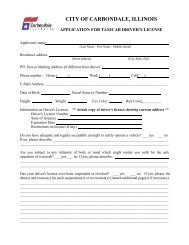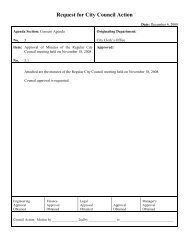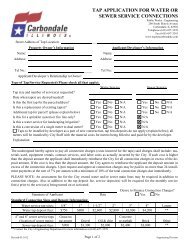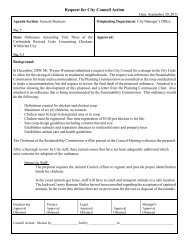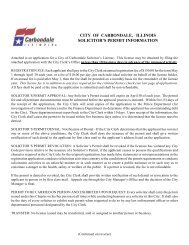Comprehensive Plan - Carbondale, IL
Comprehensive Plan - Carbondale, IL
Comprehensive Plan - Carbondale, IL
- No tags were found...
You also want an ePaper? Increase the reach of your titles
YUMPU automatically turns print PDFs into web optimized ePapers that Google loves.
Adopted June 22, 20103.3 Existing ConditionsPedestrian and Bicyclist ConnectionsAs a university community, thereis an increased propensity forwalking and bicycling. This isespecially true on and aroundcampus, which itself has a denseweb of sidewalks and pathways,but also extends to many offcampusdestinations of studentliving, shopping, and recreation(see Figure 3.1, Proposed CampusMaster <strong>Plan</strong>). Moreover, based onthe community input received,there is a call by residents forimproved pedestrian connectionscitywide. A comprehensive trailand sidewalk system wouldbe for leisure and recreation,health and fitness, better accessto the community’s parks andnatural areas, and a consciouseffort to reduce vehicle trips andlessen the use of -- and relianceon – fossil fuels. In this way, theCity could take steps to fulfill itssustainability goals.Figure 3.1 | PROPOSED CAMPUS MASTER PLANPresently, there are neighborhoods Source: Southern Illinois Universitythat have a good network ofsidewalks (both within and around the periphery) and other neighborhoods thatdo not (see Map 3.1, Existing Sidewalk System). Improving walkability requiresthe design of walkable neighborhoods and seamless connections between them.Missing sidewalk links, unusable sections, and/or poor access and street crossingtreatments at intersections can make it easier to decide to drive rather than walk inthe interest of safety. Barriers like the railroad, major arterial highways like U.S.51 and <strong>IL</strong> 13, wide and busy intersections like that at Illinois/University/Mill, andnoncontiguous development must be overcome. In short, “pedestrianism” must beconsidered in all aspects of development and design if <strong>Carbondale</strong> is to improve itsattractiveness as a place to bicycle and walk.There are places within the community that are walkable from the perspective ofhaving stores, schools, and parks in close proximity to housing. While there maybe nearby conveniences to these locations, there are also obstacles and barriers towalking/bicycling that will require good planning and design solutions.Currently, the City has several on-street and off-street trails through the moredensely developed areas of the community as pictured in Figure 3.2, BikewayRoutes (see next page). However, they are not yet tied together in a comprehensivesystem of trails, sidewalks, and pathway connectors. Fortunately, there are several<strong>Comprehensive</strong> <strong>Plan</strong>3.3Community Mobility



